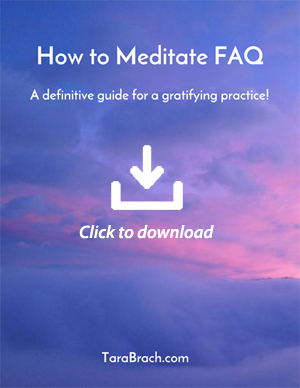View or download a print-friendly PDF version.
For More Resources on Fear, See Working with Fear
There are a number of mindfulness-based strategies that can temporarily calm us when fear is strong. These practices can be combined or sequenced in any way that you find is effective. It is ideal to develop familiarity and skill in these strategies when you are not feeling strong fear so that they will be available to you when they are most needed.
Grounding: Sitting comfortably, become aware of the sensations where your feet meet the ground; the weight of your body on your seat; the contact places where your arms or hands rest on your legs. Let your breath be slow and full, and feel the sense of gravity, of belonging to the earth. With your senses awake, recognize that I am here in this moment, right now.
You can also ground yourself by touching an object that you experience in either a pleasant or neutral way. It might be something you carry with you such as a stone, shell, pencil, piece of jewelry or meaningful talisman. Or it could be touching the fabric of your clothing or the material of a chair or sofa.
Another approach to grounding is to name ten things you are noticing in the room you are in, or name what you are seeing outside.
Resource anchors: These are places to rest the attention that can help collect and quiet the mind, as well as arouse an increased sense of ease. They can be employed separately or in some combination.
- Be aware of sensations in the body that are neutral or pleasant like the feet or hands; feeling the whole body sitting; or open to sounds and the space they are occurring in.
- Place your hand(s) gently on your heart, belly or cheek (or a combination of these) and feel the sensations of warmth and contact. You might also hug yourself.
- Mentally repeat a whispered phrase of reassurance, comfort or love: It’s okay sweetheart. I’m sorry and I love you. I’m here with you. You might also repeat a set of phrases, as in the lovingkindness or metta practice: May I be happy, may I be free from inner or outer harm, may I be peaceful, may I be free.
- Visualize something or someone that brings a sense of comfort, safety or love – a person who you trust, a place in nature where you feel at home, a spiritual figure or deity. You might imagine a loving being embracing you and/or filling you with healing light.
Titrating and pendulating: Titrating, when working with strong fear, means contacting just a little of the felt-intensity at a time. This allows you to include and integrate the experience in a stable, mindful way.
To titrate, you first set up a resource anchor (s), such as a place in the body where you feel neutral and/or pleasant sensations, or an image of a person who evokes a sense of safety. Then you pendulate – go back and forth – between the fear and your chosen resource.
Breathing slowly and deeply: Match the length of the in-breath and out-breath so they are approximately 5-6 seconds each. If it helps, count slowly to four to keep them the same length. Let the breathing be continuous, without a pause between breathing in and out.
Relax parts of your body that feel tense: Bring a gentle attention to these areas with the intention to soften, to let the sensations float in awareness. Pay particular attention to the shoulders, hands, and belly. Also relax your face, including your tongue, from the tip right to its root.
Walking meditation: Choose a walking path that is about 15 paces long. Bring your attention fully to the feet and legs and walk mindfully from one end to the other, pause, and mindfully turn and return. Continue in this way, walking back and forth at a pace that allows you to be present to your senses. When the mind wanders, come back to your senses (sights and sounds) and then fully to the sensations in your feet and legs. If it’s helpful, you might breathe rhythmically with the walking or offer messages of comfort (or lovingkindness) as described above in Resource anchors.
Gradual exposure during meditation: (Note: It is recommended to explore this with the guidance of a therapist.) Make a list of the situations, people, thoughts, images and/or feelings you are avoiding and order them from least to most intense. Begin with the least intense, with the intention to invoke it with your imagination, and meet it with mindfulness – opening to the thoughts, feelings and sensations with kindness, clarity and interest.
Mindfulness will not serve you if you enter into a window of distress. Plan ahead to either shift to one of the above strategies (like titration and pendulation) or, if the distress is strong, to another activity entirely and do something you find easeful such as having a cup of tea, calling a friend, reading a book, showering or walking in nature.
Tara Brach, Ph.D. – www.tarabrach.com
For More Resources on Fear, See “Working with Fear”
NOTE: This site is not intended to diagnose or treat any physical or mental health condition. If you are in crisis, or in need of immediate assistance, find help here:
https://yourlifecounts.org/find-help/#


